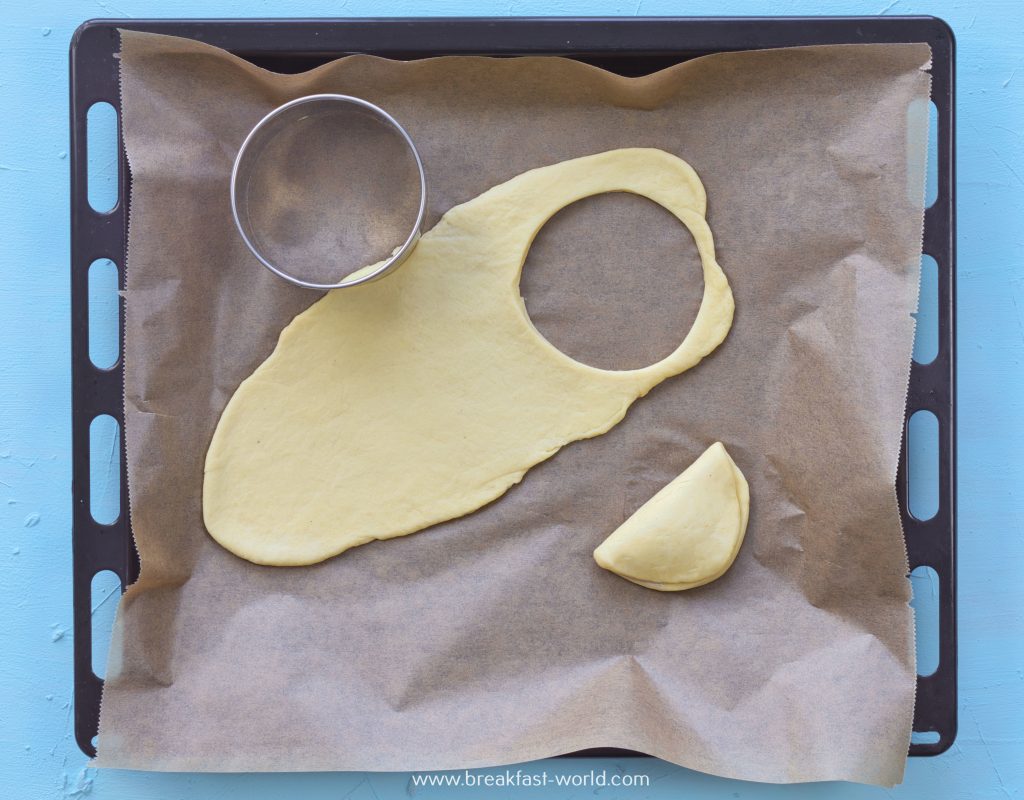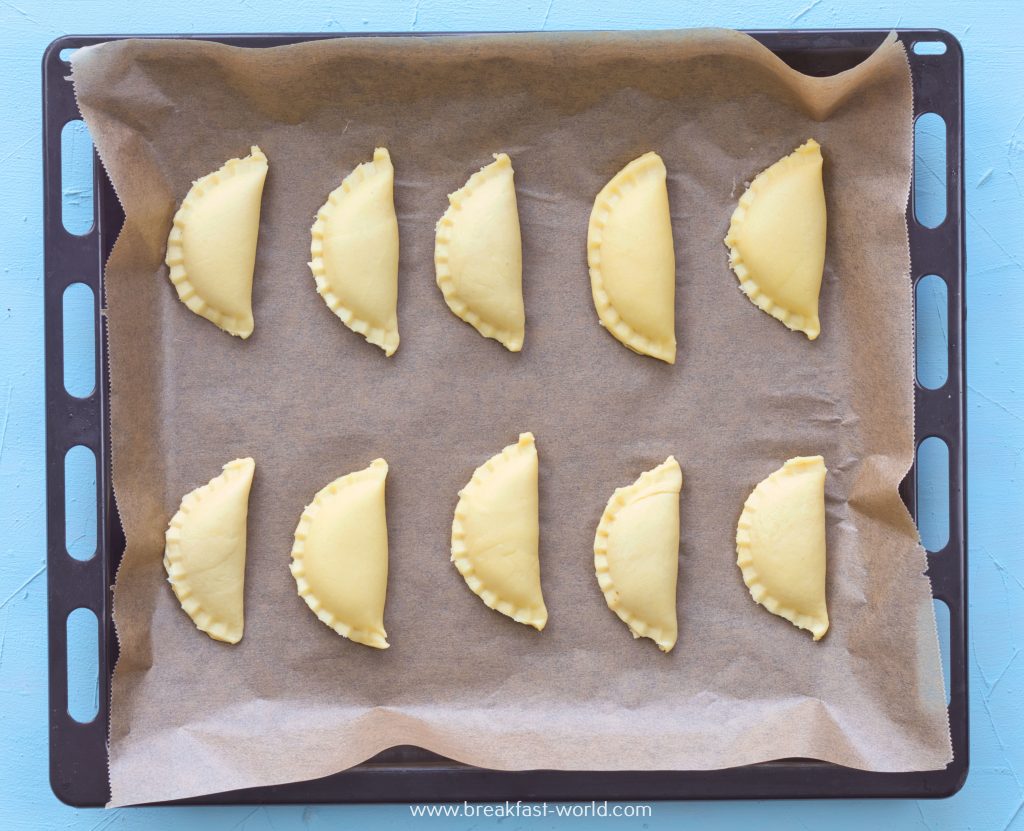Bourekia me Anari are deep-fried pastries with a sweet cream cheese (anari) filling. They are very popular for breakfast in Cyprus.
Since the Cypriot cuisine has much more to offer than Bourekia me Anari first of all some interesting information about the cuisine and breakfast in Cyprus.
Jump to RecipeCypriot cuisine
The Cypriot cuisine is mediterranean, which is characterized by the use of many fresh herbs and ingredients, such as parsley, lemon, yogurt and garlic.
Due to its history, the cuisine contains predominantly Greek, Turkish and Arabic elements. Since Cyprus was a british colony and only got indepent in 1960, there are also British influences such as fish and chips.
Cyprus is a well-wooded and mountainous island with fertile soil. Therefore, numerous fruits and vegetables such as oranges, peaches, almonds, olives, figs, pomegranates, potatoes, aubergines, tomatoes and cucumbers perfectly thrive.
Meat and fish
Meat plays a very important role in Cypriot cuisine. Especially lamb, pork, poultry, goat and rabbit are often on the menu. Beef, which was first introduced by the English, is less popular.
The national dish of Cyprus is called Kléftiko. This is lamb or goat braised in a clay pot (tawás) in a clay oven. Garlic, caraway seeds, cloves, bay leaves, cinnamon, olive oil and red wine cause the excellent taste of the dish. Kleftiko, however, is not part of everyday food, but is more likely to be eaten on Sundays.
Especially popular are Souvla (grilled meat skewers) and Sieftaliá (minced meat rolls).
One of the island's special meat specialities is Luntza. Luntza is a ham made from pork that is marinated in salt, later on in red wine and finally air-dried.
Although Cyprus is an island, the supply of native fish is rather small due to the overfishing of the Mediterranean Sea. Many of the fishes offered come from reservoirs or fish farms. Fish is is usually fried or deep-fried.
Halloumi
A particular specialty of Cyprus is Halloumi, a mildly spiced cheese made from sheep, goat or cow milk. Halloumi does not melt when heated and is therefore ideal for grilling and frying. It tastes particularly good with olive oil, lemon juice, mint, garlic and tomatoes or with watermelon or other fruits.
Meze
If you want to get an overview about the richness of Cypriot cuisine, a Mezes-evening should not be missed. Traditionally, up to thirty (!) different dishes are served. At the beginning, olives and various dips e.g. Skordalia (potato and garlic dip), Taramosalata (fish roe dip) and Tsatziki are served. There is also fresh bread and a bowl of fresh salad. Halloumi cheese and luntza are just as important as grilled meat or fish, delicious stews, vegetables and egg dishes. You will finish with fresh fruit such as watermelon, sweet pastries or confectionery.
Breakfast in Cyprus
A typical breakfast in Cyprus includes fresh figs, tomatoes, cucumber, olives, butter, halloumi or the ricotta-like Anari-cream cheese, sausage, eggs, honey, jam and yogurt with honey and fresh fruits:

The bakeries offer a variety of fresh and incredibly delicious traditional breads and pastries in the morning. You should definitely try Tahinopita, a kind of cinnamon bun made from yeast dough with Tahini (sesame paste). Fresh and still warm from the oven, they are so yummy:

My personal favorite are Bourekia me Anari. This is a deep-fried pastry filled with anari cream cheese and cinnamon:

Tips for preparing Bourekia me Anari
The preparation is pretty easy:
From flour, salt, a little olive oil and water you knead a compact, soft dough that is reminiscent to pasta dough. The dough is rolled out (approx. 1-2 mm). With a round glass or something similar, cut out circles with a diameter of approx. 10 cm:

There is about 1 teaspoon of filling for each of these circles. The filling consists of anari cream cheese (or ricotta), cinnamon, sugar and rose water. As I don't like rose water, I didn't use it:

Then, you fold the dough over the filling, so that a crescent moon is created. Alternatively, you can put another circle of dough over the filling so that you have a circular Bourekia me Anari . I chose the round shape:

The ends of the dough are firmly pressed together with a cake fork:

The whole thing perfectlty works with a ravioli cutter:

Now, you can deep-fry the Bourekia me Anari in hot oil until golden-brown.
Dusted with powdered sugar while still hot, they simply taste delicious!
If you don't like it so greasy, you can also steam the Bourekia me Anari - like ravioli - in boiling water or brush it with egg yolk and bake it in the oven at around 170 degrees golden-brown. These two variants are also very tasty, although I definitely favor the original (deep-fried) version.
Well, now that you are well informed about Bourekia me Anari nothing can go wrong with baking!

Bourekia me Anari
Zutaten
For the dough:
- 350 g flour
- 1 tsp. salt
- 50 ml olive oil
- 125 ml water (lukewarm)
For the filling:
- 250 g Anari cream cheese (alternatively: ricotta)
- 2 – 3 tbsp. sugar
- 1 tsp. cinnamon
- 1/2 tsp. Rose water (optional)
In addition:
- oil for frying
- Icing sugar for dusting
Anleitungen
For the dough:
- Mix flour with salt.
- Add olive oil and knead into a crumbly dough with your fingers.
- Slowly add the lukewarm water while continuing kneading the dough.
- Knead the dough with your hands or a food processor to form a compact, but soft dough.
- Shape the dough into a ball.
- Die Kugel von außen mit etwas Olivenöl einpinseln.
- Pack the dough airtight (e.g. vacuum seal it or seal it tightly in a freezer bag) and let it rest for at least 30 minutes.
For the filling:
- Put anari cheese (ricotta) in a mixing bowl.
- Add sugar, cinnamon and rose water. Mix the mixture well.
For finishing:
- Roll out the dough with a rolling pin (approx. 1 - 2 mm thick).
- Cut out round circles with a glass or similar (approx. 10 m diameter).

- Put about 1 teaspoon of the filling on each circle.

- Fold the circle over the filling so that the shape of a crescent moon arises.

- Press the edges of the dough together with a fork.

- Heat the oil in a large saucepan.
- Deep-fry Bourekia me Anari in portions in hot oil until golden-brown.
- Take the finished Bourekia me Anari out of the pot with a slotted spoon, place on kitchen paper to soak up the excess fat.
- Dust the Bourekia me Anari with icing sugar and serve immediately.
Notizen
If you like this post, I look forward to a rating (star bar) or a nice comment!
Thanks a lot!
Perhaps you would also like to subscribe to my page. If so you will be regularly informed about new posts.









Excellent site you have here but I was wondering if you knew of any message
boards that cover the same topics discussed here? I’d really love to be a part of community where I can get responses from other knowledgeable people that
share the same interest. If you have any recommendations, please let me know.
Bless you!
Habe gerade diesen Blog durch Zufall entdeckt und ich bin begeistert.
Ich brauche zum Frühstück immer mal Abwechslung: mal was herzhaftes, mal was süßes, mal was Einfaches, mal was Aufwändiges, da ist dieser Blog einfach ideal!
Ich freue mich schon, mich durch viele Rezepte zu kochen!
Hallo Tobi,
das freut mich sehr!! Viel Spaß beim Nachkochen und Genießen!!! LG Christina
Thx